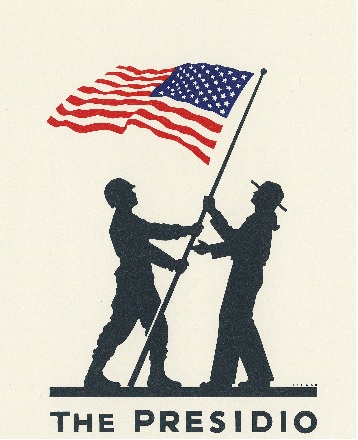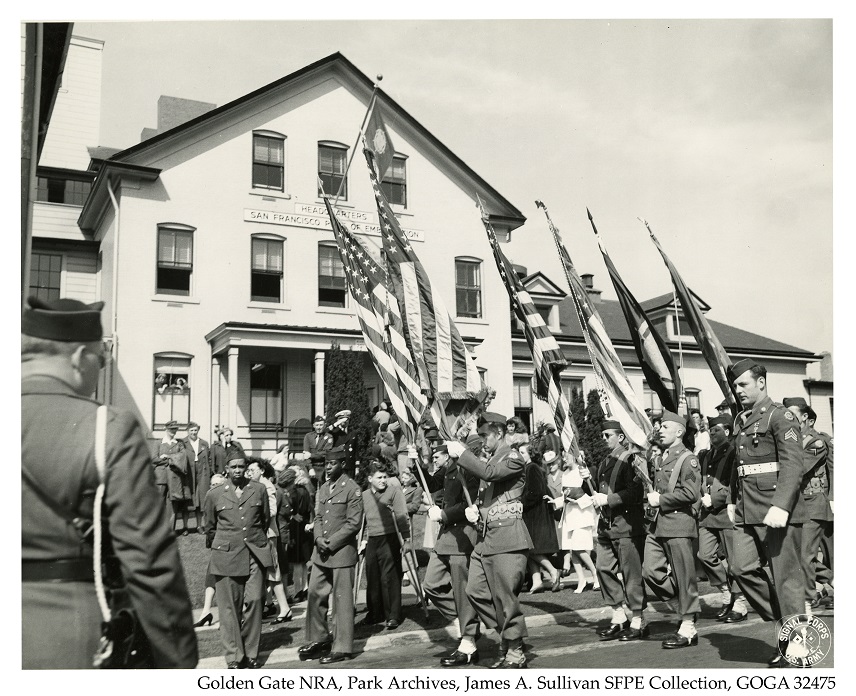 the National Park Service as part of the Golden Gate National Recreation Area, it was not just the land and structures that changed hands. Prior to the official Post to Park ceremony, the GGNRA’s Archivist spent years negotiating for the transfer of materials that would be relevant and helpful to the park once the U.S. Army had departed. Through these efforts, the GGNRA acquired nearly 3000 boxes of records, papers, correspondence, and contracts; as well as over 60,000 maps, plans and drawings associated with the structures, infrastructure and general management of this military site and its sub-installations; all significant to the future management of the facilities and in the interpretation of the Army’s activities.
the National Park Service as part of the Golden Gate National Recreation Area, it was not just the land and structures that changed hands. Prior to the official Post to Park ceremony, the GGNRA’s Archivist spent years negotiating for the transfer of materials that would be relevant and helpful to the park once the U.S. Army had departed. Through these efforts, the GGNRA acquired nearly 3000 boxes of records, papers, correspondence, and contracts; as well as over 60,000 maps, plans and drawings associated with the structures, infrastructure and general management of this military site and its sub-installations; all significant to the future management of the facilities and in the interpretation of the Army’s activities.Early work assigned temporary identification or accession numbers to each batch of materials removed from an office, and an inventory of all folder titles (often verbatim) populated a searchable database. Seven project folders might have been strewn throughout five different boxes, but all five boxes could be retrieved. A folder title may simply have read “Bldg 50,” without further description, but at least you knew there was something available (hopefully…some folders were inventoried even when empty). It wasn’t perfect, but it was control until a more in-depth archival processing could take place.
Now, over 2
 0 years later, the collections staff has completed the processing of the 3000 cubic feet of textual material. During that time the records were divided into collections that reflected the different functions or areas of the Army, like the Master Planning Branch, Maintenance Shops, Environmental Records, etc. Each group was then reviewed as they sat: evaluating each folder’s contents, making notes, tentatively assigning a series or topic, and weeding out duplicate items. Once the processing archivist had a basic understanding of the collection as a whole and conceptualized the arrangement of the materials they then went about reorganizing the boxes and folders: pulling related folders together, removing folded up oversize plans, and adding information to help locate relevant items. The seven project folders were joined into one project record, the three copies of the contract proposal was reduced to the single most readable version, and now took up part of one box instead of five. The folder titles now read “KITCHEN RENOVATION, BLDG 50 PSF [Oversize separated].” When the paper settled into its final place, properly housed in acid free enclosures and clearly labeled, and the finding aid for the individual collection was completed, the database was finally updated.
0 years later, the collections staff has completed the processing of the 3000 cubic feet of textual material. During that time the records were divided into collections that reflected the different functions or areas of the Army, like the Master Planning Branch, Maintenance Shops, Environmental Records, etc. Each group was then reviewed as they sat: evaluating each folder’s contents, making notes, tentatively assigning a series or topic, and weeding out duplicate items. Once the processing archivist had a basic understanding of the collection as a whole and conceptualized the arrangement of the materials they then went about reorganizing the boxes and folders: pulling related folders together, removing folded up oversize plans, and adding information to help locate relevant items. The seven project folders were joined into one project record, the three copies of the contract proposal was reduced to the single most readable version, and now took up part of one box instead of five. The folder titles now read “KITCHEN RENOVATION, BLDG 50 PSF [Oversize separated].” When the paper settled into its final place, properly housed in acid free enclosures and clearly labeled, and the finding aid for the individual collection was completed, the database was finally updated.Today the GGNRA’s Park Archives and Records Center still uses that one, now more thorough, database to conduct searches across multiple Army collections. Although we are unable to place a version of the database on-line we have been able to create a PDF and RTF document listing every folder title available to the general public. While it may not be as easy as searching the database itself, researchers can at least gain a sense of the type of material that is held in the archives and copy and paste the relevant lines into a separate working document.
Some suggestions for searching the document:

Think diversely, could someone have named this differently, are there terms unique to the Army, did the project or site name change over time? The Public Health Service Hospital was previously known as the Marine Hospital.
Were acronyms frequently used? PSF = Presidio of San Francisco Staff tried to spell out as many as possible, but was not always successful.
Use parts of words to broaden results and include different endings.
Spaces are useful. Adding a space in front or at the end of a term limits the results. For example, instead of looking for Building “210” use “ 210” to prevent Building 1210 from coming up.
Were acronyms frequently used? PSF = Presidio of San Francisco Staff tried to spell out as many as possible, but was not always successful.
Use parts of words to broaden results and include different endings.
Spaces are useful. Adding a space in front or at the end of a term limits the results. For example, instead of looking for Building “210” use “ 210” to prevent Building 1210 from coming up.
